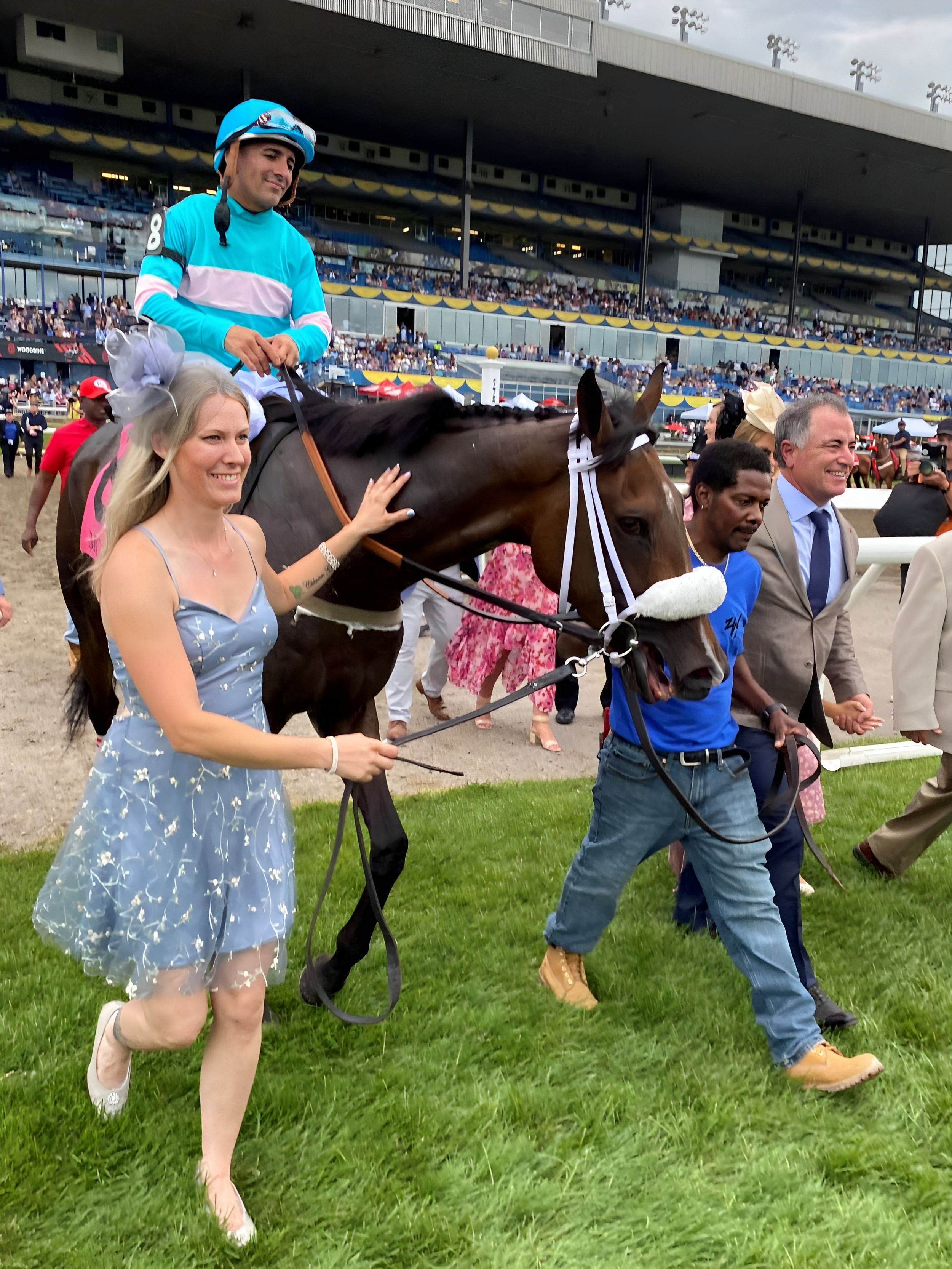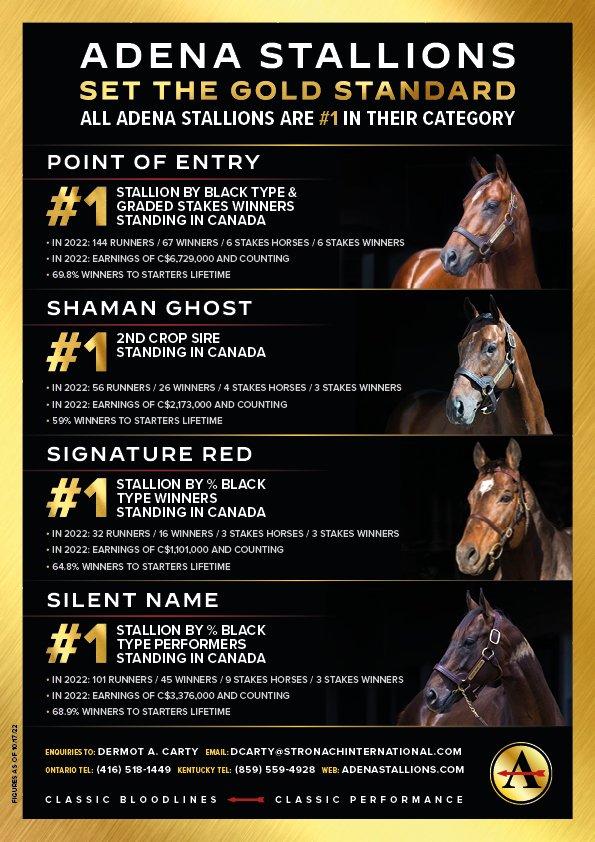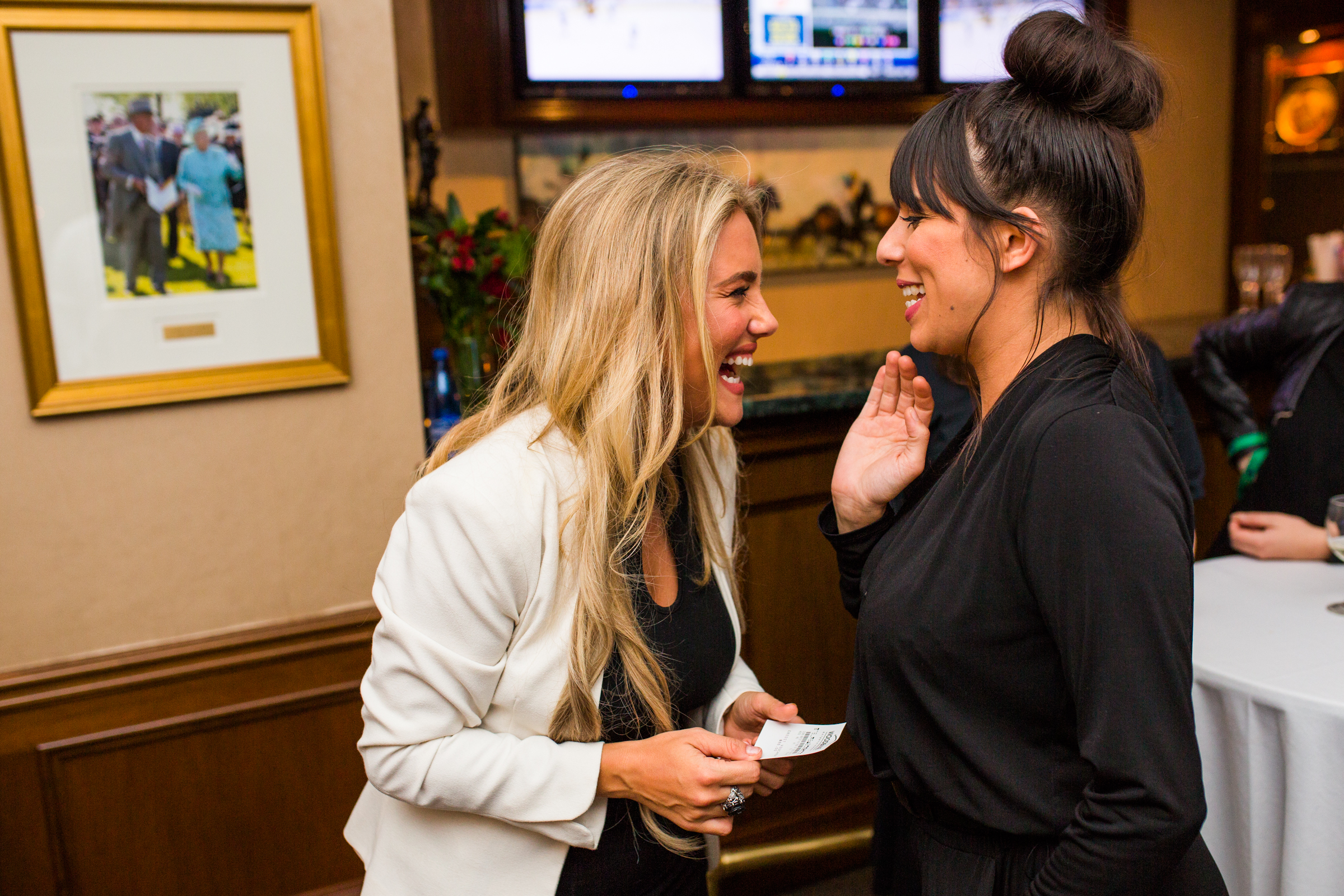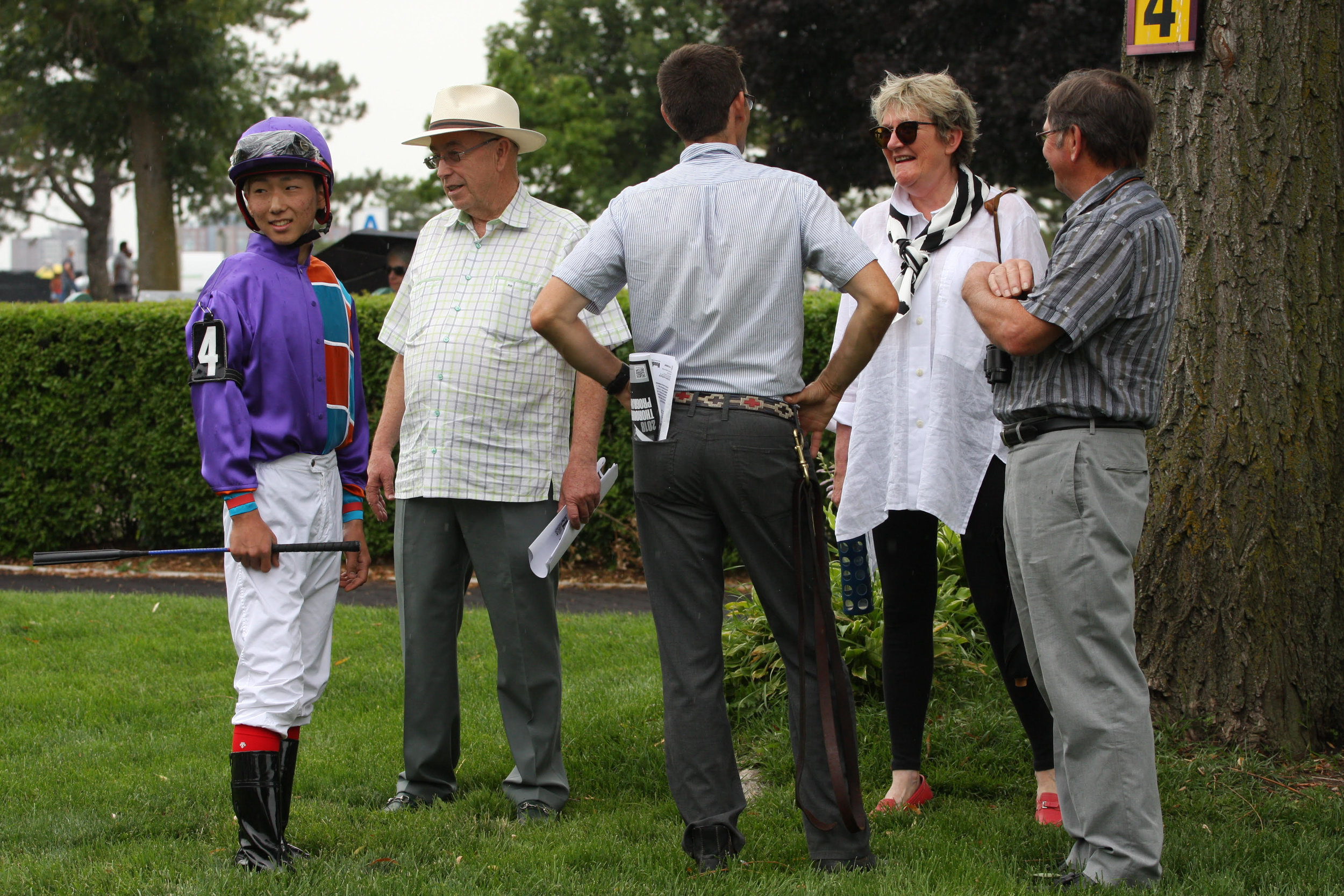Celebrating breeders - Howie Walton
/Article by Bill Heller
Howie Walton has spent his life in Toronto loving horses, riding, racing and breeding them.
“He absolutely loves his horses,” one of his trainers, John Mattine, said. “When someone has that passion for the game, you want to do well for him and succeed.”
Walton succeeded beyond his wildest imagination in business, starting his own plastics company, Norseman Plastics, and selling it for millions. That allowed him to follow his heart and make good on a promise to himself. “As a kid, I always loved horses. I said if I ever did well, I’d buy a horse.”
He bought a riding horse, Lakeview Noel, who lived to be 31 years old. Then Howie bought Quarter Horses, doing quite well with them, and switched to Thoroughbreds—making an enormous impact on Canadian racing.
“He’s great for the sport,” another one of his trainers, Jamie Attard, said. “He really is. He’s a breeder’s breeder and an owner’s owner. He’s been supporting Ontario racing for so many years.”
There are rewards for doing so, specifically for Ontario-breds and its rich supplement program. “The bonuses for Ontario-breds are fairly high,” said Walton. “I’ve always raced at Woodbine. I’ve been there a long time.”
Along the way, his concern for his horses has never wavered. “We had a horse,” recalls Attard. “His name was Buongiorno Johnny. He broke his maiden in a stakes race (winning the $150,000 restricted Vandal Stakes July 31, 2011), then he had an issue down the line. We lost the horse for $32,000 (on June 25, 2014). Three years later, he was in some bottom-level claimer (a $4,000 claimer at Thistledown). Howie paid them double the claiming price and retired him on his farm. He always lets you do what is right. If it’s the little thing, he’ll send him to the farm for some time off. He retired a six-year-old we had and gave it to my girlfriend. The horse always comes first. His heart is as big as the grandstand.”
Jamie Attard’s father, Canadian Hall of Famer Sid, also trains for Walton and echoes his son’s opinion: “If a horse is not right, he doesn’t want to run him. If I call up saying his horse has a problem, he’ll say, `Scratch him.’”
Howie Walton (blue jacket) receives the 2022 Recognition of Excellence Award at the recent 39th Annual CTHS Awards from CTHS Ontario President & National Director Peter Berringer.
There are worse calls ro receive. Sid and Howie know first-hand. Their two-year-old home-bred filly, A Touch of Red, a daughter of Howie’s top horse and now leading stallion Signature Red, won her debut by five lengths at Woodbine in a maiden $40,000 claimer last September 19. On October 10, she won the $100,000 South Ocean Stakes for Ontario-breds by a neck as the even-money favorite.
“She was breezing seven days before her next race,” Sid said. “She worked by herself that day. She’s going five-eighths. Good bug boy on her. He noticed something wrong. He pulled her up. She started shaking. She died. Looked like a heart attack. She was such a nice, nice filly. Beautiful. Big. Strong. I was never so shocked in my life.”
Sid called Howie and told him the tragic news. “I said, `Howie, I’m very, very sorry.’”
Walton replied, “Sid, don’t worry about nothing. It’s nobody’s fault.”
He and Sid have another talented filly who just turned three, another home-bred daughter of Signature Red, Ancient Spirit. She won a maiden $40,000 claimer by four lengths, the $100,000 Victoria Queen Stakes by 2 ½ and concluded her two-year-old season with a second by a neck in the South Ocean Stakes to her stable-mate, A Touch of Red. The torch has been passed on.
A couple months after A Touch of Red’s death, Walton said, “In this game, you have good-luck and bad-luck horses. She won a stakes race and had a heart attack and died.”
As if that wasn’t bad enough, Howie then endured the removal of his gallbladder. ”It wasn’t fun,” he said. He leaned on his family, his wife of 47 years Marilyn, their adult sons Benjamin, who is 43, works for his dad with his apartment building investments; and 42-year-old Michael, who is in the plastics business. The Waltons have four grandchildren and a standard poodle named Riley. “A house isn’t a home unless you have a dog in it,” Howie said. “Poodles are as smart as hell.”
So is his owner. “I was a pretty smart guy; I went to the University of Toronto, and I was a chemical engineer. I did well with plastics.”
He did incredibly well with the company he started. “I had it for 30, 40 years,” Walton said. “It got pretty big. It was quite an operation. I had 500, 600 people under me. We had plants around the states. I had big clients: Pepsi Cola, Coca Cola, all the milk companies—you name them. It turned out to be a $230 million company. I started at zip.”
How did he do it the first time? “I worked like hell; I wasn’t married. We used to run 24 hours, seven days a week. I don’t know if I could do it again.”
Marilyn isn’t surprised that her husband succeeded. “When he does something, he puts 150 percent into it. He makes up his mind, and he’s very focused. He was a born salesman. He knows how to talk to people, how to treat people.”
She also knows how resourceful Howie can be.
Marilyn and Howie lived near each other but hadn’t met. “We used to pass each other going to work on the same day. Then one day he wrote down my license plate. In those days, you could do that and look a person up.
“We met. We were engaged in three months and married three months after that; and we’ve been married 47 years.”
Marilyn was impressed with Howie’s horsemanship. “It started with the Quarter Horses. What I really loved about it was he was not the person who goes to the races and just watches. He went to the barn and used to clean their feet after the race. He really cares for animals. He is a true animal lover. He loves dogs. Same thing with Thoroughbreds. He truly, truly loves them. He always had a passion for them.”
Signature Red (rail side) wins the 2011 Highlander Stakes.
The horse Howie Walton is most passionate about is Signature Red. “John Mattine’s dad, Tony, picked out Signature Red," recalled Howie. (Red is Howie’s favorite color.)
John said, “My father trained for him. He was basically his first trainer. My dad bought everything for him before. Most of the good broodmares he has trace back to my dad.”
Racing from the age of three until he was six, Signature Red, a son of Bernstein out of Irish and Foxy by Irish Open, won six of 27 starts, including two consecutive runnings of the Gr. 2 Highlander Turf Stakes in 2010 and 2011, and earned $630,232.
Buongiorno Johnny before his 2011 Vandal Stakes win.
He stands at Frank Stronach’s Adena Springs in Aurora, Ontario, for C$5,000 this year and has now sired the winners of 168 races through the end of 2022. His progeny has earned more than C$6.2 million.
“I think he’s the best value stud in Canada,” says Walton. Accordingly, he has continually sent his best mares to Signature Red. “I believe in him.”
He also believes in the value of Signature Red’s offspring. That’s why at last year’s CTHS Ontario Premier Yearling Sale, he bought back three Signature Red yearlings as well as a filly by Red Explosion, a son of Signature Red, for a combined total of C$290,000. “Not really a hard decision,” said Walton. “My stock is very high quality. I believe in my stock. I believe in my stud.”
Howie has become friends with Adena’s farm manager Sean Smullen and farm owner Frank Stronach. “In 2002, he started putting some horses in here—layups. We developed a good relationship over the years. The man—he loves his animals. No matter what’s wrong, he’ll do it to save the animal. There’s no expense too big to care for his horse. He wants to give it a quality of life. He’s very loyal,” says Smullen.
Walton cherishes his friendship with Frank Stronach. “I’ve known him for a long time. He’s a dynamic guy. Anyone building an electric car plant at the age of 90 … there aren’t many guys like him. As a businessman, I admire that. I told him that. He said, `I guess I’ve made a few billion in my life.’ He’s quite a guy. I hope he lives to be 200. When he’s gone, I don’t know who’s going to run his operation. When he had his tiff with his daughter, he told me, `Howie, it’s only money. I’ll make more.’”
One of Walton’s home-breds made quite a bit of money out of just six starts before being sold. Maritimer, trained by Sid Attard, won his maiden debut by a head and then finished second by a head to his stable-mate Buongiorno Johnny in that 2011 Vandal Stakes. Maritimer then finished second in an allowance race, a late-tiring fourth in the Gr. 3 Summer Stakes and first in two stakes: the $250,000 Coronation Futurity by 2 ½ lengths then the $175,000 Display by 5 ½ lengths. After being sold, he went winless in four starts, including fifth in the Gr. 2 Autumn Stakes at Woodbine. He failed to hit the board in three starts in Dubai, including an 11th in the Gr. 2 U.A.E. Derby.
Though he concentrates on Thoroughbreds, Walton still has Quarter Horses. “What attracted me was the horse. They were big. They were strong. They were smart and beautiful. Not as edgy as a Thoroughbred. I still have a few.”
He treats them the same way he treats Thoroughbreds. And the same way he treats people: love, loyalty and a laser-like focus. “I am a loyal guy,” he said. “If I don’t like you, I’ll tell you.”
Marilyn put it this way: “What you see is what you get.”
Howie Walton and trainer Sid Attard with Generous Touch and jockey Eurico Rosa da Silva.






























